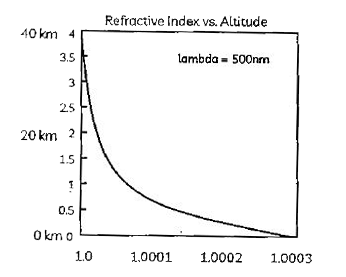Refraction observed in the atmosphere.
When a ray of light passes obliquely from an optically rarer medium to an optically denser medium, it bends towards the normal at the point of incidence. If opposite is the case, the ray bends away from the normal.
Atmosphere is never static. Air is mobile and its density and temperature are not uniform. As a result, in general , the path of a ray of light through atmosphere of varying refractive index is a curve. The refractive index of cool air is greater than that of hot air.
Atmospheric refraction of light results in many intersecting optical phenomena such as twinkling of a star, advanced sunrise and delayed sunset, mirage and flickering of an object seen through a turbulent stream of hot air rising from a fire.
Topper's Solved these Questions
- REFRANCTION OF LIGHT BOOK - NAVNEET PUBLICATION - MAHARASHTRA BOARDCHAPTER - REFRANCTION OF LIGHT EXERCISE - NUMERICAL PROBLEMS FOR PRACTICE
6 Videos
- REFRANCTION OF LIGHT BOOK - NAVNEET PUBLICATION - MAHARASHTRA BOARDCHAPTER - REFRANCTION OF LIGHT EXERCISE - Text
29 Videos
- QUESTIONS BASED ON THE TABLE AND FLOW CHART BOOK - NAVNEET PUBLICATION - MAHARASHTRA BOARDCHAPTER - QUESTIONS BASED ON THE TABLE AND FLOW CHART EXERCISE - Space Missions
1 Video
- REMEDIES/MEASURES ON PROBLEMSBOOK - NAVNEET PUBLICATION - MAHARASHTRA BOARDCHAPTER - REMEDIES/MEASURES ON PROBLEMSEXERCISE - CHAPTER 10 : DISASTER MANAGEMENT
1 Video
Similar Questions
Knowledge Check
The graph below shows variation of refractive index of earth's atmosphere with altitude.

Select the correct observations:
(I) The refractive index of earth is gradually increasing with decrease in altitude
(II) Star tight will get scattered more on entering the earth's atmosphere before reaching earth's surface.
(III) Star light will get bend more away from the normal as it reaches the earth's surface.
(IV) Star light will get bend more towards the normal as it reaches the earth's surface.ABoth (I) and (II)BBoth (I) and (IV)CBoth (II) and (III)DBoth (II) and (IV)Assertion (A): On a clear summer night twinkling of stars is observed.
Reason (R) : The twinkling of stars is caused by dispersion of star light by the atmosphere.ABoth A and R are true, and R is correct explanation of the assertion.BBoth A and R are true, but R is not the correct explanation of the assertion.CA is true, but R is false.DA is false, but R is true.Assertion : The rainbow is an example of the dispersion of sunlight by the water drops in the atmosphere.
Reason : No reflection or refraction of light is involved in the formation of rainbow.AIf both assertion and reason are true and reason is the correct explanation of assertion.BIf both assertion and reason are true and reason is not the correct explanation of assertion.CIf assertion is true but reason is false.DIf both assertion and reason are false.
What is the correct reason for blinking / flickering of stars ? Explain it.
a. The blasts in the stars.
b. Absorption of star light by the atmosphere.
c. Motion of the stars.
d. Changing refractive index of gases in the atmosphere.
View SolutionName two effects produced by the atmospheric refraction.
View SolutionAtmospheric Refraction|Reason Of Atmospheric Refraction|Phenomena In Nature|Twinkling Of Stars|Stars Twinkle At Night But Planets Do Not Twinkle At All. Why?|Stars Seem Higher Than They Actually Are|Questions|Home Work|Summary
View SolutionWe know that light refracts (or bends) when it goes from one medium to another. Now, the atmosphere contains only air. Then how does light get refracted on passing through only air in the atmosphere ?
View SolutionAssertion :- The twinkling of stars is due to the fact that refractive index of the earth's atmosphere fluctuates.
Reason :- In cold countries, the phenomenon of looming (i.e ship appears in the sky) takes place, because refractive index of air decreases with height.
View Solution
